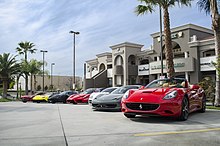
A supercar, also known as an exotic car, is a type of automobile generally described at its most basic as a street-legal sports car with race track-like power, speed, and handling, plus a certain subjective cachet linked to pedigree, exclusivity, or both.[1] The term 'supercar' is frequently used for the extreme fringe of powerful, low-bodied mid-engineed luxury sportscars. A low car has both a low, handling-favorable center of gravity, and less frontal area than a front engined car, reducing its aerodynamic drag and enabling a higher top speed. Since the 2000s,[citation needed] the term hypercar has come into use for the highest performance supercars.[citation needed]
Supercars commonly serve as the flagship model within a vehicle manufacturer's sports car range, and typically feature various performance-related technology derived from motorsports. Some examples include the Ferrari 458 Italia, Lamborghini Aventador, and McLaren 720S. By contrast, automotive journalism typically reserves the predicate 'hypercar' for (very) limited, (two- to low 4-figure) production-number cars, built over and above the marque's typical product line-up and carrying 21st century sales prices often exceeding a million euros, dollars or pounds: examples would include the 1270 unit Porsche's Carrera GT, Ford GTs, and the Ferrari F40/F50/Enzo lineage. Very few car makers, like Bugatti and Koenigsegg, only make hypercars.
In the United States, the term "supercars" was used already during the 1960s for the highest performance muscle cars. As of 2024, "supercars" is still used in Australia to refer to Australian muscle cars.[citation needed]